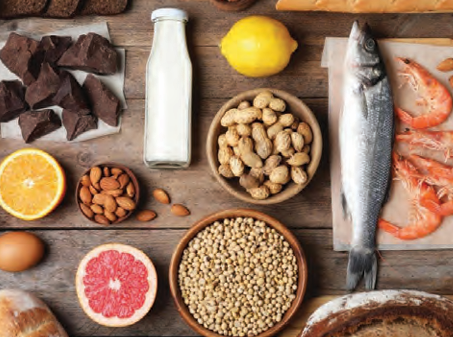Food is at the heart of our lives; it brings people together, carries cultural significance, and is a source of joy and comfort. But for those dealing with food tolerances or allergies, this relationship can become complicated, even overwhelming. The simple act of eating can transform into a maze of labels, substitutions, and worries about health risks.
For some, it’s the frustration of constant bloating after a favorite meal. For others, it’s the anxiety of avoiding life-threatening reactions from a tiny ingredient. These challenges can feel isolating, but they don’t have to rob you of the pleasure and nourishment food offers.
By understanding the differences between tolerances and allergies, and learning how to manage them, you can take back control of your diet and health without sacrificing the joy of eating.
For those navigating these challenges, knowledge is power and the right nutritional choices can make all the difference.
Food Tolerance vs. Food Allergy: What’s the Difference? Food Tolerance (or Intolerance) Food tolerance occurs when the body has difficulty digesting certain foods.
For those navigating these challenges, knowledge is power and the right nutritional choices can make all the difference.
It is typically a digestive system response and does not involve the immune system. Common examples include lactose intolerance, gluten sensitivity (non-celiac), and issues with certain food additives like sulfites.
Symptoms can range from bloating, gas, and diarrhea to headaches and fatigue.
Food Allergy
In contrast, a food allergy is an immune system reaction to a specific food protein. Even a small amount of the allergen can trigger a response, which may range from mild (hives, swelling) to severe (anaphylaxis). Common allergens include peanuts, shellfish, tree nuts, and eggs.
The key distinction is that food allergies can be life-threatening, while intolerances, though uncomfortable, are generally less severe.
Nutritional Challenges Of Food Tolerances And Allergies
Living with food sensitivities or allergies can be daunting, especially when trying to maintain a balanced diet. Eliminating certain foods often means risking nutrient deficiencies, particularly if the restricted foods are staples in a typical diet.
Common Nutritional Gaps And Solutions
Lactose Intolerance
Missing Nutrient: Calcium and Vitamin D
Alternatives: Fortified plant-based milks (almond, soy, or oat), leafy greens, tofu, and fortified orange juice.
Gluten Sensitivity or Celiac Disease
Missing Nutrients: Fiber, B vitamins (especially folate and niacin), and iron.
Alternatives: Quinoa, brown rice, millet, and gluten-free whole grains.
Nut Allergies
Missing Nutrient: Healthy fats and Vitamin E.
Alternatives: Seeds like flaxseed, sunflower seeds, and chia seeds.
Egg Allergies
Missing Nutrient: Protein and certain vitamins like B12.
Alternatives: Tofu, legumes, and fortified cereals.
Managing Food Tolerances And Allergies With Smart Nutrition
Read Labels Religiously
Food labels can be lifesavers. For individuals with allergies, it is critical to look out for hidden ingredients. Similarly, those with intolerances can check for additives that might trigger reactions.
Consult a Registered Dietitian
Professional guidance ensures you get essential nutrients while managing your condition. A dietitian can help design a diet plan that suits your needs, free from allergens or intolerant foods.
Try Substitution And Rotation Diets
Substitute allergenic foods with safe and nutritious alternatives. Rotation diets can help those with intolerances avoid overexposure to specific foods.
Recipe: Dairy-Free Calcium Boost Smoothie
This quick recipe is perfect for anyone with lactose intolerance looking to get a calcium boost without dairy.
Ingredients:
1 cup fortified almond milk
1 cup spinach (rich in calcium)
1 banana (for natural sweetness)
1 tablespoon chia seeds
½ cup frozen mango
Instructions:
Combine all ingredients in a blender.
Blend until smooth.
Serve immediately and enjoy the nutrient-packed goodness!
Nutritional Benefits:
Rich in calcium, fiber, and vitamins A and C
Free from dairy and gluten, making it suitable for most dietary needs.
Remember, nutrition is not about deprivation; it is about adaptation. With the right knowledge and tools, you can nourish your body while still enjoying the pleasures of food.





